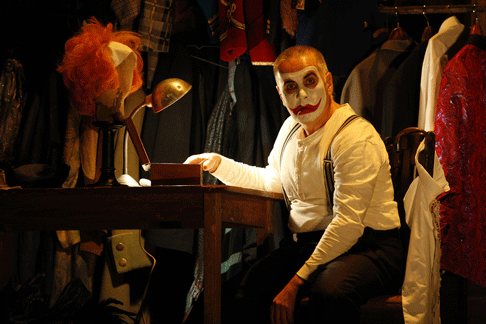29 Nov 2010
Rigoletto, Opera Australia
Not revived too frequently this 1991 production by Elijah Moshinsky updates the story to the 1960s and the films of Federico Fellini inspire the sets and costumes.

Not revived too frequently this 1991 production by Elijah Moshinsky updates the story to the 1960s and the films of Federico Fellini inspire the sets and costumes.
The revival is even more welcome thanks to the outstanding performances of Michael Lewis and Rigoletto and Emma Matthews as Gilda.
The swinging, cynical sixties Moshinsky creates is the perfect world for the Duke. Paparazzi swarm around his act one party where showgirls dance with bishops.
Act one springs along in this updated guise, the circus-like party music even sounding like the sort of music Fellini’s regular composer Nino Rota would have written had he lived a century earlier.
Michael Yeargan’s revolving ‘doll house’ set shows the Duke’s palace, the street where Rigoletto meets Sparafucile, Rigoletto’s house and Sparafucile’s inn. A quick quarter turn in acts two and four and you have some open space for Gilda’s abduction and the final father-daughter duet. It all works splendidly and is another of Opera Australia’s landmark productions. The set also concentrates the action close to the front of the stage so, when the many set pieces come along, the characters are conveniently up stage nicely placed to deliver their arias.
Michael Lewis is a model Verdi baritone, perfect diction, smooth legato and clear, ringing top. Lewis exploits every note of the music, sung and unsung, to convey character. Seen during the prelude, applying a grotesque clown make-up (anticipating Heath Ledger’s Joker from Batman), Lewis’s Rigoletto then stands to show this Rigoletto’s extra handicap. Crippled, Lewis beetles about on walking sticks. Lewis’s thirty years singing the role bring insights into the character’s words and music illuminate every dimension of Rigoletto’s tragedy big and small from his terrified freeze at Monterone’s curse to the perfectly timed pause and wild yowl when Gilda dies.
Emma Matthews is radiant as Gilda. Mentored in the role by Joan Sutherland, she now takes the highest alternatives at the close of “Caro nomo”, singing with a security and sophistication that would make her late, great predecessor proud. Matthews’s acting matches her singing and she creates an understandably fatalistic young woman out of Gilda. Her murder scene is actually shocking; she strides fearlessly into the tavern so Maddalena seems to see it is a woman, not a man, and shrieks with horror as Gilds is stabbed. Jacqueline Dark, in the unlikely double act of Gilda’s untrustworthy guardian and then co-assassin brings a Freudian undertone perfectly in keeping with the story.
Rosario la Spina makes less of the Duke than his colleagues seeming to sing without much involvement but this has the advantage of suggesting the Duke’s detachment from his many victims.
 Michael Lewis as Rigoletto [Photo by Jeff Busby courtesy of Opera Australia]
Michael Lewis as Rigoletto [Photo by Jeff Busby courtesy of Opera Australia]
Conductor Marko Letonja and Orchestra Victoria do some splendid work with shaping the tender moments. The Rigoletto/Gilda duets are as lovingly shaped as they are sung and the often-repeated ‘curse’ theme and storm music are thrilling without being bombastic.
Michael Magnusson